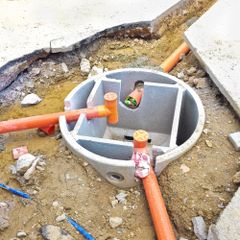What Are the Key Components of a Septic System?

Without a reliable septic system, there’d be no way to eliminate waste from your property. The equipment breaks down and treats sewage for safe redistribution into the environment. Although the system plays an important role in maintaining a comfortable home, septic installation only involves placing three key pieces of equipment just below the earth’s surface. To better care for your investment, identify problems as soon as they arise, and prevent accidental damage, below is a look at the different parts and how each portion functions.
What Is the Anatomy of a Septic System?
A Septic Tank Collects Household Waste
Waste sent down toilets and drains filters to the septic tank. The sewage separates into three layers in the watertight, pre-cast concrete container. Solids settle at the bottom and form the sludge layer, while grease floats to the top as the scum layer. The wastewater, or effluent, in the middle flows out of the septic tank to the nearby distribution box before filtering into a leach field. The sludge remains in the tank, which is why it should be pumped every few years. Otherwise, there will be no room for more waste to enter the chamber, leading to sewage backups inside the house.
The Distribution Box Evenly Filters Effluent Into the Leach Field
 Effluent flows from a pipe in the septic tank to the distribution box. The container should be placed downhill of the tank, as it makes it easier to receive the liquid. The small holding container has a series of perforated pipes attached to the other side, which extend farther into the yard. The effluent flows through the channels for even distribution in the leach field.
Effluent flows from a pipe in the septic tank to the distribution box. The container should be placed downhill of the tank, as it makes it easier to receive the liquid. The small holding container has a series of perforated pipes attached to the other side, which extend farther into the yard. The effluent flows through the channels for even distribution in the leach field.
The Leach Field Removes any Remaining Impurities
During septic installation, the perforated leach field lines are placed in absorption trenches. In the leach field, the pipes are surrounded by crushed stone and sand and are covered with a layer of topsoil. When effluent seeps out of the drainage pipes, aerobic digestion and filtration take place in the slime around the laterals. Wastewater passes through the film and into the soil and sand, which filters out any remaining impurities. The water then returns to the water table. Invasive roots can puncture the pipes and cause sewage to seep into the yard, which is why the septic system should be installed away from vegetation.
If you need septic installation, the professionals at Jeff Simek Construction Company in Ogema, WI, will oversee every aspect of the project. With 28 years of experience, they will secure the proper permits, provide land clearing and additional services to prepare the site, find the best location for excavation, and ensure equipment is installed correctly. To schedule septic installation in Price County, call (715) 767-5295. Visit the excavating contractors online to learn more about their credentials.
About the Business
Have a question? Ask the experts!
Send your question

